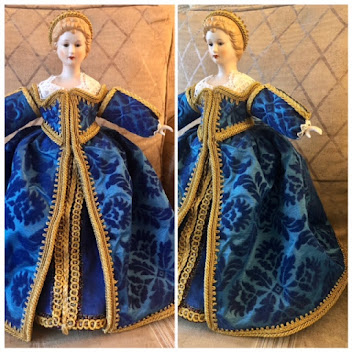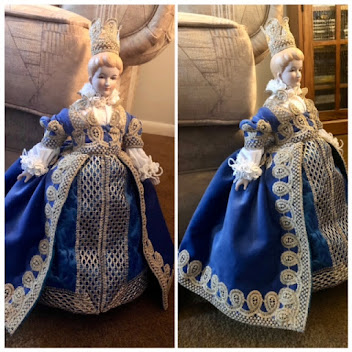Sometimes one has to have a step back and realize the driving force behind your passions. On this very blog I have discussed in length; how to make fashion dolls, where they came from, who owned them, what were fashion dolls made from, when were fashion dolls used. Missing one of the very important question... Why? Why do you focus on this unusual niche topic? Why should someone like yourself, care about Fashion dolls?
The quick answer is Fashion as we know it today, would not be the power house it is without the Fashion doll. Additionally the historic styles from medieval and early renaissance clothing would not be as iconic without the influence from Fashion Dolls. That might seem a bit sweeping but lets start at the beginning. Dolls are documented from the stone age. For fashion references, dolls were used since classical through medieval times. They were written about and were dressed in fine clothing and had finely crafted miniature accessories. Fashion dolls really came into their own and transformed in the early renaissance, to convey fashion communication all over Europe. Fashion dolls also were sent to the new world to show fashions to the the many different colonies to have clothing made in the updated style. A noted export for France to the New World, fashion dolls were part of the economy in trade. Also trade in dolls from the Netherlands to England is noted in shipping records dating back from Tudor,
The function of the dolls were important to those in the trade of making clothing: tailors, seamstresses, milliners, shoemakers and fabric sellers all had a stake in these dolls. There was a profitable market in making the dolls, to sell the fabric, to eventually make the clothes and accessories. Direct marketing of supply and demand was important in this trade. Fashion Dolls had influence on people purchasing what the doll was wearing in full size clothing, they were a great advertisement of skill for those in the trade.
 The Fashion Doll would be dressed in such a way that a Tailor could use the reference of shape on a human form, to draft their patterns from the physical shapes created by the clothing on the doll. Translating those shapes into a pattern for full scale clothing for clients. These dolls were small items in hand and a few liberties may have been taken for the sake of scale. The most important function is visual and tactile communication though a physical object. Its easy to replicate something if you have proper reference that is three-dimensional. These Fashion dolls also could be of varying size and materials; as found per reference to life size in one source for notable marriage negotiations and lavishly dressed great babe in the Inventory of Henry VIII to name a few. Catherine De Medici, Mary Queen of Scots, Isabella d' Este all had fashion dolls in their inventories, so not a one off.
The Fashion Doll would be dressed in such a way that a Tailor could use the reference of shape on a human form, to draft their patterns from the physical shapes created by the clothing on the doll. Translating those shapes into a pattern for full scale clothing for clients. These dolls were small items in hand and a few liberties may have been taken for the sake of scale. The most important function is visual and tactile communication though a physical object. Its easy to replicate something if you have proper reference that is three-dimensional. These Fashion dolls also could be of varying size and materials; as found per reference to life size in one source for notable marriage negotiations and lavishly dressed great babe in the Inventory of Henry VIII to name a few. Catherine De Medici, Mary Queen of Scots, Isabella d' Este all had fashion dolls in their inventories, so not a one off.
It is clear from the portraits of dolls, many I have shown on this blog. The clothes depicted in Pre-16th century portraits of children holding dolls were not generically dressed. The Fashion dolls clothing were regionally and class specific and were very detailed in the depictions. The portrait of Arabella Stuart age 3 comes to mind, the child is holding a highly detailed blond haired fashionably coifed hair in a courtly full red embroidered 1560's French gown with a suite of neck ruff and wrist cuffs, ever detail on show. This tells us exactly what was popular, especially to make this level of verisimilitude. The one surviving extant Fashion doll in the Livrustkammaren Museum in Stockholm, Sweden; shows the fine attention to detail that these had in real life. She is just the one lucky survivor from the age, who knows the stunning ones lost to time.
The Elizabethan clothing as we know it, borrowed from many styles available during the 16th century. As seen in the list of country specific clothing in the Queen's wardrobe from Queen Elizabeth's Wardrobe Unlock'd by Janet Arnold. This would have not been possible with just description alone or with a woodcut or drawing. Queen Elizabeth I had received various fashion dolls as part of negotiations for several marriages, per the accompanying correspondence. Queen Elizabeth I was known for her fashion sense and would dress to the occasion when dignitaries were visiting, as per written observations in period. How you dressed as important, so you needed to be kept informed on fashion.
 Fashion Dolls are still used in fashion today to communicate and to teach just as it did in the 16th century. These are more like the 19th century dress form, a descendant of the fashion doll and milliners mannequin. Dior's Fall Collection 2020 as the runway was not accessible with the spread of Covid-19. See the link for pictures and article Dior Fall 2020. At the School of Historical Dress, 1/2 scale dress forms are used to teach pattern drafting, draping and other skills for making historic styled clothing. This is not the only fashion school that uses this method for teaching.
Fashion Dolls are still used in fashion today to communicate and to teach just as it did in the 16th century. These are more like the 19th century dress form, a descendant of the fashion doll and milliners mannequin. Dior's Fall Collection 2020 as the runway was not accessible with the spread of Covid-19. See the link for pictures and article Dior Fall 2020. At the School of Historical Dress, 1/2 scale dress forms are used to teach pattern drafting, draping and other skills for making historic styled clothing. This is not the only fashion school that uses this method for teaching.
In closing, 16th Century clothing would have not been as fashionably iconic if fashion communication wasn't happening from other locations. The regional clothing styles; especially the ones we know just by looking at them. Those styles would not be as easily recognizable if a Fashion Doll wasn't dressed to show off that particular style in the period. Which influenced the doll owner to have that clothing be made up into a full size version and worn. The fashion dolls influenced through their tactile communication the styles of the century, which evolved as the century marched on-wards. Something as small as a Fashion Doll made all that happen. In their own ways are still influencing Fashion today.






No comments:
Post a Comment